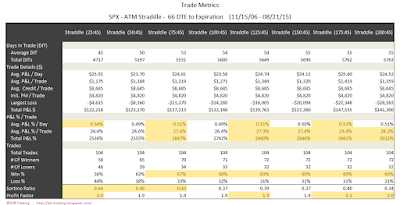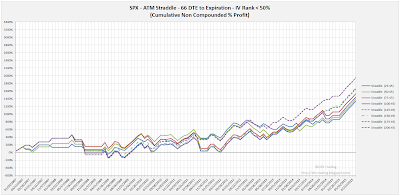For background on the setup for the backtests, as well as the nomenclature used in the charts and tables below, please see the introductory article for this series: Option Straddle Series - P&L Exits.
No IV Rank Filter
In this section we look at the results of entering one trade for every monthly expiration regardless of the implied volatility rank (IVR) of the SPX on the date of entry. Entering these trades at 66 DTE and utilizing our loss exits and 45% credit exits (described here), resulted in the equity curves below. These curves are very similar to the variations without profit management, covered in the first 66 DTE post.
 |
| (click to enlarge) |
The trade metrics for these different exits are shown in the table below. The (175:45) variation stood out with the second best P&L % / day reading, the highest P&L % per trade reading, the highest total P&L % value, and the highest win rate (of 69%). Three other variations also had win rates of 69%. Compared to the corresponding metrics for the 59 DTE variations, the P&L % per trade and total P&L % are better. But, the corresponding 59 DTE variations had better P&L % per trade readings and win rates.
 |
| (click to enlarge) |
The table below shows the distribution of returns in five-number summary format. Hat-tip to tastytrade.
 |
| (click to enlarge) |
Below are three sets of scatter plots for selling 66 DTE ATM SPX straddles. The first image contains one scatter plot per strategy and shows P&L in percentage terms versus IVR for the SPX. The IVR was captured on the day each trade was initiated. The trend of increasing P&L with increasing IVR is very clear.
 |
| (click to enlarge) |
The next image shows P&L in percentage terms versus initial ATM IV. This ATM IV was captured on the day each trade was initiated. Higher IV resulted in higher returns, but the majority of the profitable and unprofitable trades occurred at lower IV...below 35.
 |
| (click to enlarge) |
The third image shows P&L in percentage terms versus days-in-trade (DIT). In order to extract 45% of the credit, the trade duration needs to be longer...this is clearly evident with the clustering of profitable trades above 40 DIT. At the higher loss management levels, 100% and greater, most of the losses were realized at expiration. This is the same pattern we noticed with the 59 DTE trades using the 45% win management level.
 |
| (click to enlarge) |
IV Rank > 50% Filter
In this section we will look at the results of entering one trade for every monthly expiration only when the IVR of the SPX is greater than 50% ( >50% ). Entering these trades at 66 DTE and utilizing our loss exits and 45% credit exits (described here) resulted in the equity curves below. These are the best returns for the 45% credit exit for all of the DTE tested up to this point.
 |
| (click to enlarge) |
The trade metrics for these different exits are shown in the table below. As we've seen with the earlier articles, there are significantly fewer trades that meet the >50% IVR criteria...23 out of 104 possible trades. The top variations (highlighted in yellow) had higher P&L% per day readings, higher P&L% per trade values, better win rates and larger profit factors than the non-IVR filtered variations. Also, in general, the top performers managed losers quickly...at the 75%, 100%, and 1255% loss levels. The best performer of the group was the (75:45) variation.
 |
| (click to enlarge) |
The table below shows the distribution of returns in five-number summary format.
 |
| (click to enlarge) |
IV Rank < 50% Filter
In this section we will look at the results of entering one trade for every monthly expiration only when the IVR of the SPX is less than 50% ( <50% ). Entering these trades at 66 DTE and utilizing our loss exits and 45% credit exits (described here) resulted in the equity curves below. These filtered trades have had a very good run all of 2015, but starting as early as mid-2013...this is a familiar patter for this IVR filter level.
 |
| (click to enlarge) |
The trade metrics for these different exits are shown in the table below. Using the lower IVR filter did not improve any of the metrics. The best performer of the group was a tie between the (175:45) and (200:45) variations.
 |
| (click to enlarge) |
The table below shows the distribution of returns in five-number summary format.
 |
| (click to enlarge) |
In the next post I'll summarize the automated backtest results of the 66 DTE ATM SPX short straddles, before moving on to the 73 DTE straddle series.
Follow my blog by email, RSS feed or Twitter (@DTRTrading). All options are available on the top of the right hand navigation column under the headings "Subscribe To RSS Feed", "Follow By Email", and "Twitter".
2 comments:
Seems to be a strong correlation between a higher profit target, and initial days to expiration. Looking back and comparing charts for profit of 35% and 45% from 38 DTE to 66 DTE, it is pretty plain that you need more days to get to that profit level on a consistent basis. Also, the 10% profit level seems to be hurt the longer the initial DTE. 25% profit level isn't as clear yet. After going through this blog several times, I am going to be doing my straddles differently now than I would have originally, and I feel much clearer on the expectation long term.
This is such great information. Thanks again.
Hi Josh,
Thank you for the comments...I really appreciate them.
I'm still working through the results for all of the test runs...I will be adding 73 DTE and 80 DTE results over the next two weeks. Many of the trends that have been present will continue at these higher DTEs. After these two DTE are posted, I will move on to the combined results of all of the tests. From what I've reviewed up to this point, it appears that the 52 DTE and 66 DTE results don't seem to follow the general DTE trends. This appears to be related to a few extra bad trades in these two test runs, but I still need to dig a bit deeper.
Thanks again for sharing your feedback.
Dave
Post a Comment